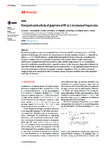Transport conductivity of graphene at RF and microwave frequencies
| dc.contributor.author | Awan, Shakil | |
| dc.contributor.author | Lombardo, A | |
| dc.contributor.author | Colli, A | |
| dc.contributor.author | Privitera, G | |
| dc.contributor.author | Kulmala, TS | |
| dc.contributor.author | Kivioja, JM | |
| dc.contributor.author | Koshino, M | |
| dc.contributor.author | Ferrari, AC | |
| dc.date.accessioned | 2016-06-15T21:53:52Z | |
| dc.date.available | 2016-06-15T21:53:52Z | |
| dc.date.issued | 2016-03 | |
| dc.identifier.issn | 2053-1583 | |
| dc.identifier.issn | 2053-1583 | |
| dc.identifier.other | 15010 | |
| dc.identifier.uri | http://hdl.handle.net/10026.1/4909 | |
| dc.description.abstract |
Wemeasure graphene coplanar waveguides from direct current (DC) to a frequency f = 13.5 GHz and show that the apparent resistance (in the presence of parasitic impedances) has an ω2 dependence (where ω = 2πf), but the intrinsic conductivity (without the influence of parasitic impedances) is frequency-independent. Consequently, in our devices the real part of the complex alternating current (AC) conductivity is the same as the DC value and the imaginary part is ∼0. The graphene channel is modeled as a parallel resistive-capacitive network with a frequency dependence identical to that of the Drude conductivity with momentum relaxation time ∼2.1 ps, highlighting the influence of ACelectron transport on the electromagnetic properties of graphene. This can lead to optimized design of high-speed analog field-effect transistors, mixers, frequency doublers, low-noise amplifiers and radiation detectors. | |
| dc.format.extent | 0-0 | |
| dc.language.iso | en | |
| dc.publisher | IOP Publishing | |
| dc.subject | graphene | |
| dc.subject | high frequency | |
| dc.subject | electronics | |
| dc.title | Transport conductivity of graphene at RF and microwave frequencies | |
| dc.type | journal-article | |
| dc.type | Journal Article | |
| plymouth.author-url | https://www.webofscience.com/api/gateway?GWVersion=2&SrcApp=PARTNER_APP&SrcAuth=LinksAMR&KeyUT=WOS:000373936300030&DestLinkType=FullRecord&DestApp=ALL_WOS&UsrCustomerID=11bb513d99f797142bcfeffcc58ea008 | |
| plymouth.issue | 1 | |
| plymouth.volume | 3 | |
| plymouth.publisher-url | http://dx.doi.org/10.1088/2053-1583/3/1/015010 | |
| plymouth.publication-status | Published online | |
| plymouth.journal | 2D Materials | |
| dc.identifier.doi | 10.1088/2053-1583/3/1/015010 | |
| plymouth.organisational-group | /Plymouth | |
| plymouth.organisational-group | /Plymouth/Faculty of Science and Engineering | |
| plymouth.organisational-group | /Plymouth/Faculty of Science and Engineering/School of Engineering, Computing and Mathematics | |
| plymouth.organisational-group | /Plymouth/REF 2021 Researchers by UoA | |
| plymouth.organisational-group | /Plymouth/REF 2021 Researchers by UoA/UoA12 Engineering | |
| plymouth.organisational-group | /Plymouth/Users by role | |
| plymouth.organisational-group | /Plymouth/Users by role/Academics | |
| dcterms.dateAccepted | 2015-11-30 | |
| dc.identifier.eissn | 2053-1583 | |
| dc.rights.embargoperiod | Not known | |
| rioxxterms.funder | EPSRC | |
| rioxxterms.identifier.project | Novel Point-of-Care Diagnostic Techniques for Dementia | |
| rioxxterms.versionofrecord | 10.1088/2053-1583/3/1/015010 | |
| rioxxterms.licenseref.uri | http://www.rioxx.net/licenses/all-rights-reserved | |
| rioxxterms.type | Journal Article/Review | |
| plymouth.funder | Novel Point-of-Care Diagnostic Techniques for Dementia::EPSRC |


